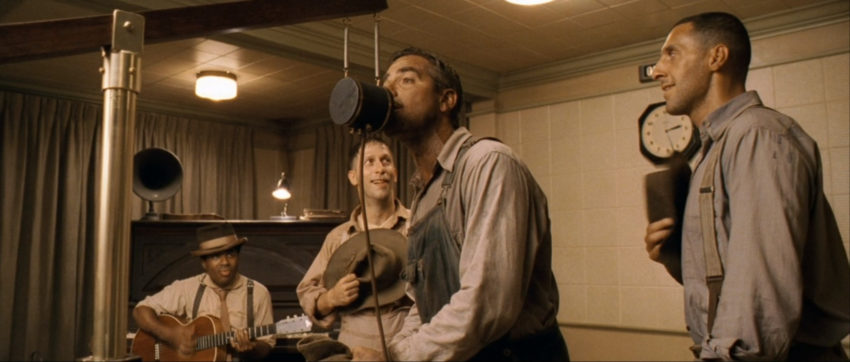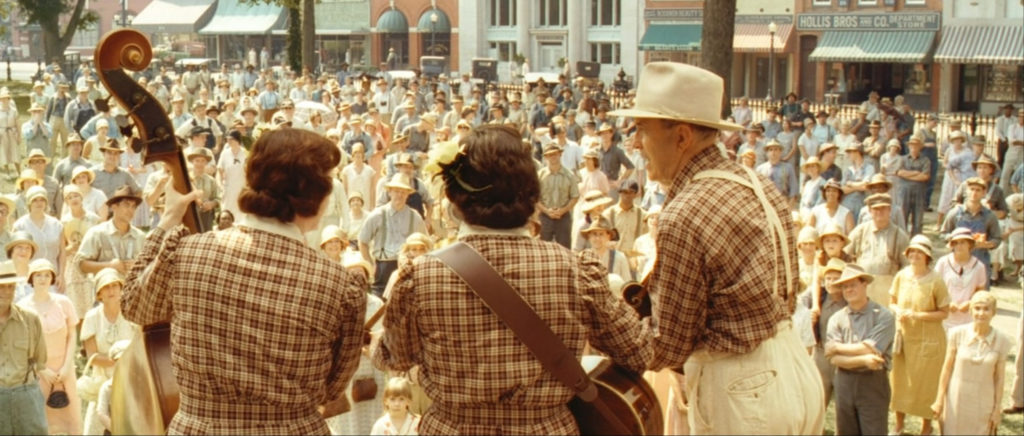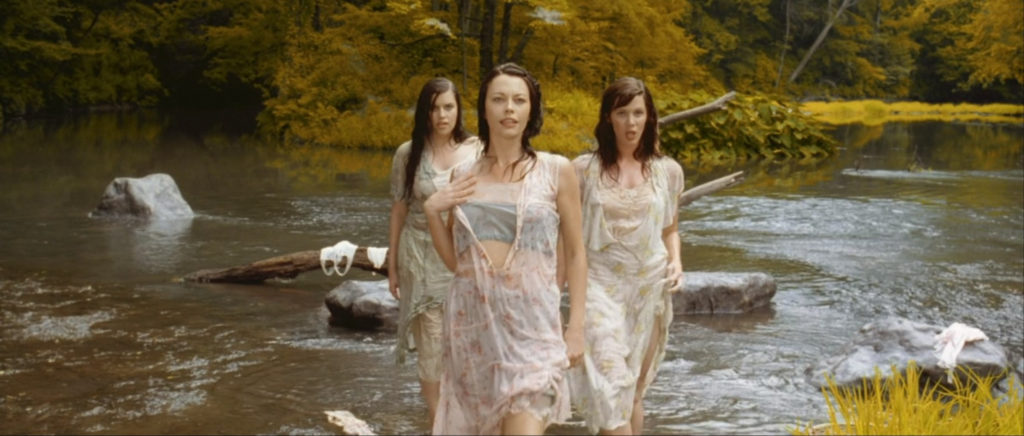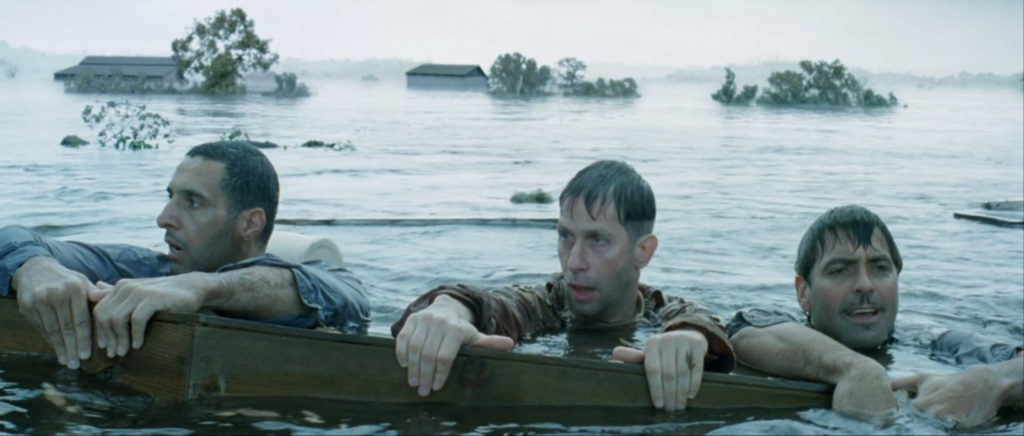
I don’t remember precisely the first time I watched O Brother, Where Art Thou?. I may have caught some of it as a kid one afternoon, as my mom watched it, thinking my sister and I were busy. My mom may have let me watch the whole thing when I was still too juvenile to appreciate its picaresque rhythms. I know that I saw at least part of the movie when I was pretty young, because I do remember two things clearly:
- I had never seen the white, hooded robes of the KKK before I saw the cross burning scene in O Brother, Where Art Thou?. I don’t think I really knew about the KKK at all before I saw this scene.
- I had never heard the word “miscegenation” until I heard it in O Brother, Where Art Thou?. I vaguely remember my mom explaining to me what it meant, but maybe I just put it together later.
(It bears mentioning that the film, despite being set in the Jim Crow South, doesn’t substantively engage with anti-Black racism. But, then again, neither did my education up to that point.)
I can recall the first time I took pleasure in watching the movie. In my freshman year of highschool, I had English class with a “cool” teacher. He was young and a real hipster, which, in 2007, was still cool to a bunch of fourteen-year-olds. In retrospect, he tried very hard.* (I should say that, at the time, I liked this teacher and thought his assignments were fun. Although, to this day, I’m not sure if I remember his class because he was a good teacher or because his class was the only one I shared with the boy on whom I had a raging crush that year.) After we read The Odyssey, this teacher showed us O Brother, Where Art Thou?, and we had to write about how the film worked as an adaptation. I think he skipped the cross burning scene entirely to avoid getting into any potential trouble with the school.
This English class viewing finally unlocked the film’s humor for me. For months, I couldn’t stop quoting the movie. I made my mom and sister watch it with me again at home fairly soon after I saw it in class. Particular favorite quotes included:
- “R-U-N-N-O-F-T”
- “Damn, we’re in a tight spot!” (x3, naturally)
- “Well ain’t this place a geographical oddity? Two weeks from everywhere!”
- “They loved him up and turned him into a… a horny toad!”
- “I’m the damn paterfamilias!”
Each subsequent viewing of the film has opened up new avenues of enjoyment and frameworks for interpretation. Nothing about the movie changes, of course, but every time I rewatch it, something new reveals itself. O Brother, Where Art Thou? is the rare movie that I appreciate not just in different ways but that I appreciate more every time I watch it. I couldn’t Revisit, with a capital R, the film for the twentieth anniversary because I revisit it—casually, like an old friend, with a lowercase r—whenever the fancy takes me. I seem to come back to the film every few years or so. It’s not a well-worn old favorite, exactly, but these repeated viewings over such a long period of time have made the film feel foundational to me in some way.

The film’s influences include Greek myth and epic poetry (specifically, The Odyssey), Depression-era South Americana, and 1930’s Hollywood screwball comedies (notably, the film’s title comes from Preston Sturges’ 1941 Depression-set comedy Sullivan’s Travels**). The film isn’t necessarily interested in recreating any of these things faithfully; rather, the Coen Brothers take these influences, remix them, and present them in sepia-filtered digital photography that looks like the forerunner of the faux-vintage early Instagram aesthetic. O Brother is sort of a satire, sort of an homage, and sort of confounding.
Critics sometimes consider O Brother to be minor Coen Brothers. In a recent ranking of the directors’ films for The Ringer, Sean Fennessey called it, not unkindly, “a vibe more than a movie.” If you’re into that sort of thing, rankings of the Coens’ filmography rather consistently place O Brother somewhere in the lower middle. A consensus appears to have formed that the success of the movie’s Grammy-winning soundtrack, assembled by producer T Bone Burnett, transcended the film. Indeed, most of the pieces published so far for the twentieth anniversary of the film’s release have been about the soundtrack album, not the movie itself.
As chronicled in an anniversary deep dive for Pitchfork published earlier this year, the O Brother, Where Art Thou? soundtrack had lasting reverberations in the music industry. Music critics widely credit the popular soundtrack for reviving mainstream interest in Appalachian folk and bluegrass music and, perhaps indirectly, leading to the indie folk revival of the late aughts and early ‘10s. Considering the soundtrack in isolation, as an album divorced from the context of the film, is certainly possible and occasionally interesting.
I like the soundtrack album, which my mom bought after it won Album of the Year at the Grammys in 2002. She would play it in the car, where the new CDs usually got put on rotation, and, after a while, in the house when the mood struck her. The soundtrack, along with The Chicks’ album Home (also from 2002), unquestionably served as my introduction to bluegrass and instilled in me a love of the genre. In some ways, my relationship with the O Brother, Where Art Thou? soundtrack follows the narrative traced by music and entertainment journalists alike.
My memories of the music and the film aren’t necessarily separate, though. I have a hard time thinking of them independently of one another. I can’t hear “I Am Man of Constant Sorrow” without seeing George Clooney’s Everett launching into the song in front of a tin can microphone, wide-eyed and looking side to side as he searches for Delmar (Tim Blake Nelson) and Pete (John Tuturro) to come back him up.*** I can’t hear “Didn’t Leave Nobody but the Baby” and not remember the sirens, in their wet, white cotton dresses, sitting in the river and sexily doing laundry. “O Death,” of course, conjures the cross burning scene.

As I watched the film most recently, it occurred to me how much the music bolsters the structure of the movie. O Brother, Where Art Thou? is a loosely plotted collection of vignettes, ostensibly about Everett returning home after escaping a hard labor sentence. Delmar and Pete come along because, well, all three of them are chained together when Everett makes his escape. This trio’s misadventures constitute the majority of the film, which ultimately doesn’t build a strong narrative arc out of these episodes. If each episode were a Lego brick, the movie would look like… a line of Legos. That is to say, the parts don’t seem to make anything exceptionally interesting when looked at all together.
I don’t feel like the parts necessarily need to add up to anything. The Odyssey is also highly episodic. Do you remember how you read it in class? The teacher would pick the most famous “books”—Circe’s island, the cyclops, Scylla and Carybdis, Odysseus disguising himself as an old man to trick Penelope’s suitors—and you’d read those. The narrative arc of The Odyssey is quite simple, and the excitement comes from the smaller stories within the larger epic.
The music in O Brother complements and reinforces the film’s anecdotal structure. Each vignette (with a smattering of exceptions, because nothing about this film is regular) features a song either sung diegetically in the scene or played non-diegetically over it. I realized that the songs work as markers; I remember the scene by the song or the song by the scene. If pressed, I could probably recount the incidents in the film sequentially because I know the order of the songs. The music organizes the film’s episodes in my memory, and the consistency of the musical style creates a tonal throughline.
Scholars know that ancient epic Greek poetry, including Homer’s Iliad and Odyssey, was sung. Epic poetry was an oral tradition before the stories got written down, and bards would use established systems of meter and melody to semi-improvise the performance of a tale. The bard would know the scenarios and motifs of a story and fit them into the schematic song as he performed. I know film is a fixed medium—what’s depicted on screen doesn’t vary—but watching O Brother, Where Art Thou? after a few years feels like this: I know the music, and the plot details and themes fit with it differently every time I reȅxperience the story.
As my observations and musings about the film pile up with each new viewing, I wonder if any of my thoughts about it will ever cohere into a unifying theory. I don’t subscribe to the idea that any piece of art is a puzzle to be solved, but repeatedly searching for new meaning in a work can sometimes lead to a sense of holistic understanding. But the more I watch O Brother, the more I am convinced that the film is designed to resist comprehensive interpretation. The ideas I’ve laid out here about the integral role of the soundtrack won’t “crack” the film. They’re just my latest reflections on it, prompted by my twentieth anniversary rewatch.
Perhaps the next time I come back to O Brother, and I notice something new, I’ll return to this blog post and add my thoughts. The discursive nature of the movie inspires digressive discussion. I’m never sure what fresh train of thought the movie will elicit or what old memories it will resurface. Only one thing about watching the film remains inevitable. “Man of Constant Sorrow” will be stuck in my head on a loop by the time I get to the end credits.

*A peek into my writing process: Did I Google this teacher while I was writing this, starting down a procrastination rabbit hole? Yes. Is this teacher pretty much exactly how I remembered him, based on his Twitter and his LinkedIn? Yes.
**In Sullivan’s Travels, the main character is a film director who wants to make a serious, social-issues drama called, you guessed it, O Brother, Where Art Thou. The studio heads want him to make an escapist comedy instead, “with a little sex in it,” because they think it will sell better.
***Can we take one moment to pause and appreciate how well George Clooney lip syncs for his life?? Masterclass. Also, for the purpose of this blog post, all song titles refer to the soundtrack versions of the songs.